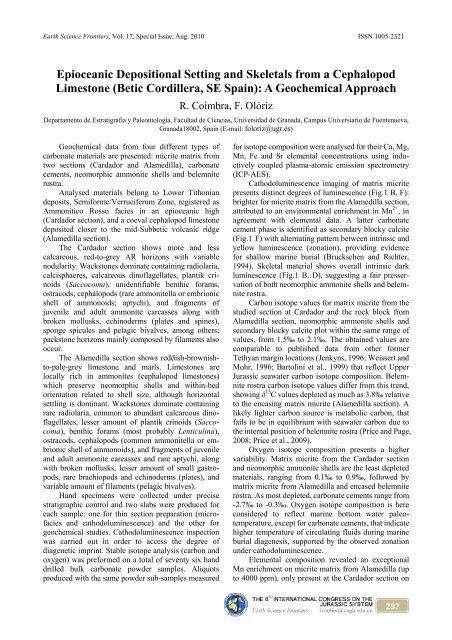in Jurassic and Cretaceous Stratigraphy
in Jurassic and Cretaceous Stratigraphy
in Jurassic and Cretaceous Stratigraphy
You also want an ePaper? Increase the reach of your titles
YUMPU automatically turns print PDFs into web optimized ePapers that Google loves.
Earth Science Frontiers, Vol. 17, Special Issue, Aug. 2010 ISSN 1005-2321<br />
Epioceanic Depositional Sett<strong>in</strong>g <strong>and</strong> Skeletals from a Cephalopod<br />
Limestone (Betic Cordillera, SE Spa<strong>in</strong>): A Geochemical Approach<br />
R. Coimbra, F. Olóriz<br />
Departamento de Estratigrafía y Paleontología, Facultad de Ciencias, Universidad de Granada, Campus Universiario de Fuentenueva,<br />
Granada18002, Spa<strong>in</strong> (E-mail: foloriz@ugr.es)<br />
Geochemical data from four different types of<br />
carbonate materials are presented: micrite matrix from<br />
two sections (Cardador <strong>and</strong> Alamedilla), carbonate<br />
cements, neomorphic ammonite shells <strong>and</strong> belemnite<br />
rostra.<br />
Analysed materials belong to Lower Tithonian<br />
deposits, Semiforme/Verruciferum Zone, registered as<br />
Ammonitico Rosso facies <strong>in</strong> an epioceanic high<br />
(Cardador section), <strong>and</strong> a coeval cephalopod limestone<br />
deposited closer to the mid-Subbetic volcanic ridge<br />
(Alamedilla section).<br />
The Cardador section shows more <strong>and</strong> less<br />
calcareous, red-to-grey AR horizons with variable<br />
nodularity. Wackstones dom<strong>in</strong>ate conta<strong>in</strong><strong>in</strong>g radiolaria,<br />
calcisphaeres, calcareous d<strong>in</strong>oflagellates, plantik cri-<br />
noids (Saccocoma), unidentifiable benthic forams,<br />
ostracods, cephalopods (rare ammonitella or embrionic<br />
shell of ammonoids; aptychi), <strong>and</strong> fragments of<br />
juvenile <strong>and</strong> adult ammonite carcasses along with<br />
broken mollusks, ech<strong>in</strong>oderms (plates <strong>and</strong> sp<strong>in</strong>es),<br />
sponge spicules <strong>and</strong> pelagic bivalves, among others;<br />
packstone horizons ma<strong>in</strong>ly composed by filaments also<br />
occur.<br />
The Alamedilla section shows reddish-brownish-<br />
to-pale-grey limestone <strong>and</strong> marls. Limestones are<br />
locally rich <strong>in</strong> ammonites (cephalopod limestones)<br />
which preserve neomorphic shells <strong>and</strong> with<strong>in</strong>-bed<br />
orientation related to shell size, although horizontal<br />
settl<strong>in</strong>g is dom<strong>in</strong>ant. Wackstones dom<strong>in</strong>ate conta<strong>in</strong><strong>in</strong>g<br />
rare radiolaria, common to abundant calcareous d<strong>in</strong>o-<br />
flagellates, lesser amount of plantik cr<strong>in</strong>oids (Sacco-<br />
coma), benthic forams (most probably Lenticul<strong>in</strong>a),<br />
ostracods, cephalopods (common ammonitella or em-<br />
brionic shell of ammonoids), <strong>and</strong> fragments of juvenile<br />
<strong>and</strong> adult ammonite carcasses <strong>and</strong> rare aptychi, along<br />
with broken mollusks, lesser amount of small gastro-<br />
pods, rare brachiopods <strong>and</strong> ech<strong>in</strong>oderms (plates), <strong>and</strong><br />
variable amount of filaments (pelagic bivalves).<br />
H<strong>and</strong> specimens were collected under precise<br />
stratigraphic control <strong>and</strong> two slabs were produced for<br />
each sample: one for th<strong>in</strong> section preparation (micro-<br />
facies <strong>and</strong> cathodolum<strong>in</strong>escence) <strong>and</strong> the other for<br />
geochemical studies. Cathodolum<strong>in</strong>escence <strong>in</strong>spection<br />
was carried out <strong>in</strong> order to access the degree of<br />
diagenetic impr<strong>in</strong>t. Stable isotope analysis (carbon <strong>and</strong><br />
oxygen) was preformed on a total of seventy six h<strong>and</strong><br />
drilled bulk carbonate powder samples. Aliquots<br />
produced with the same powder sub-samples measured<br />
for isotope composition were analysed for their Ca, Mg,<br />
Mn, Fe <strong>and</strong> Sr elemental concentrations us<strong>in</strong>g <strong>in</strong>du-<br />
ctively coupled plasma-atomic emission spectrometry<br />
(ICP-AES).<br />
Cathodolum<strong>in</strong>escence imag<strong>in</strong>g of matrix micrite<br />
presents dist<strong>in</strong>ct degrees of lum<strong>in</strong>escence (Fig.1 B, F):<br />
brighter for micrite matrix from the Alamedilla section,<br />
attributed to an environmental enrichment <strong>in</strong> Mn 2+ , <strong>in</strong><br />
agreement with elemental data. A latter carbonate<br />
cement phase is identified as secondary blocky calcite<br />
(Fig.1 F) with alternat<strong>in</strong>g pattern between <strong>in</strong>tr<strong>in</strong>sic <strong>and</strong><br />
yellow lum<strong>in</strong>escence (zonation), provid<strong>in</strong>g evidence<br />
for shallow mar<strong>in</strong>e burial (Bruckschen <strong>and</strong> Richter,<br />
1994). Skeletal material shows overall <strong>in</strong>tr<strong>in</strong>sic dark<br />
lum<strong>in</strong>escence (Fig.1 B, D), suggest<strong>in</strong>g a fair presser-<br />
vation of both neomorphic ammonite shells <strong>and</strong> belem-<br />
nite rostra.<br />
Carbon isotope values for matrix micrite from the<br />
studied section at Cardador <strong>and</strong> the rock block from<br />
Alamedilla section, neomorphic ammonite shells <strong>and</strong><br />
secondary blocky calcite plot with<strong>in</strong> the same range of<br />
values, from 1.5‰ to 2.1‰. The obta<strong>in</strong>ed values are<br />
comparable to published data from other former<br />
Tethyan marg<strong>in</strong> locations (Jenkyns, 1996; Weissert <strong>and</strong><br />
Mohr, 1996; Bartol<strong>in</strong>i et al., 1999) that reflect Upper<br />
<strong>Jurassic</strong> seawater carbon isotope composition. Belem-<br />
nite rostra carbon isotope values differ from this trend,<br />
show<strong>in</strong>g δ 13 C values depleted as much as 3.8‰ relative<br />
to the encas<strong>in</strong>g matrix micrite (Alamedilla section). A<br />
likely lighter carbon source is metabolic carbon, that<br />
fails to be <strong>in</strong> equilibrium with seawater carbon due to<br />
the <strong>in</strong>ternal position of belemnite rostra (Price <strong>and</strong> Page,<br />
2008; Price et al., 2009).<br />
Oxygen isotope composition presents a higher<br />
variability. Matrix micrite from the Cardador section<br />
<strong>and</strong> neomorphic ammonite shells are the least depleted<br />
materials, rang<strong>in</strong>g from 0.1‰ to 0.9‰, followed by<br />
matrix micrite from Alamedilla <strong>and</strong> encased belemnite<br />
rostra. As most depleted, carbonate cements range from<br />
-2.7‰ to -0.3‰. Oxygen isotope composition is here<br />
considered to reflect mar<strong>in</strong>e bottom water paleo-<br />
temperature, except for carbonate cements, that <strong>in</strong>dicate<br />
higher temperature of circulat<strong>in</strong>g fluids dur<strong>in</strong>g mar<strong>in</strong>e<br />
burial diagenesis, supported by the observed zonation<br />
under cathodolum<strong>in</strong>escence.<br />
Elemental composition revealed an exceptional<br />
Mn enrichment on micrite matrix from Alamedilla (up<br />
to 4000 ppm), only present at the Cardador section on<br />
297

















